Growth Guide: When and how to scale your accounting department
.webp)
Growth is good. Growth can also be, particularly for a function built on cyclical, predictable procedures, unpredictable and challenging.
Scaling across the business typically leads to significant expansion in financial duties, requiring new team members and accounting strategies to ensure that finance records remain accurate and up-to-date. All of which can feel daunting.
When does hiring additional team members make sense? What typical problem areas should you expect as you scale? What typically are the stages of scaling a team?
Our team broke down the when, how, and what to expect of scaling as a roadmap for your team to reference as your organization grows.
When it’s time to grow your accounting team
The financial operations landscape is changing. With software reducing the amount of manual work needed, leaner teams in finance and accounting are now the norm.
But software can’t solve all problems. Even with tech stacks and automations, adding new roles is critical, especially as organizations scale.
So then when is best? Timing is everything when scaling. Too late and you risk employee churn and performance decline. Too early and you use company resources unwisely.
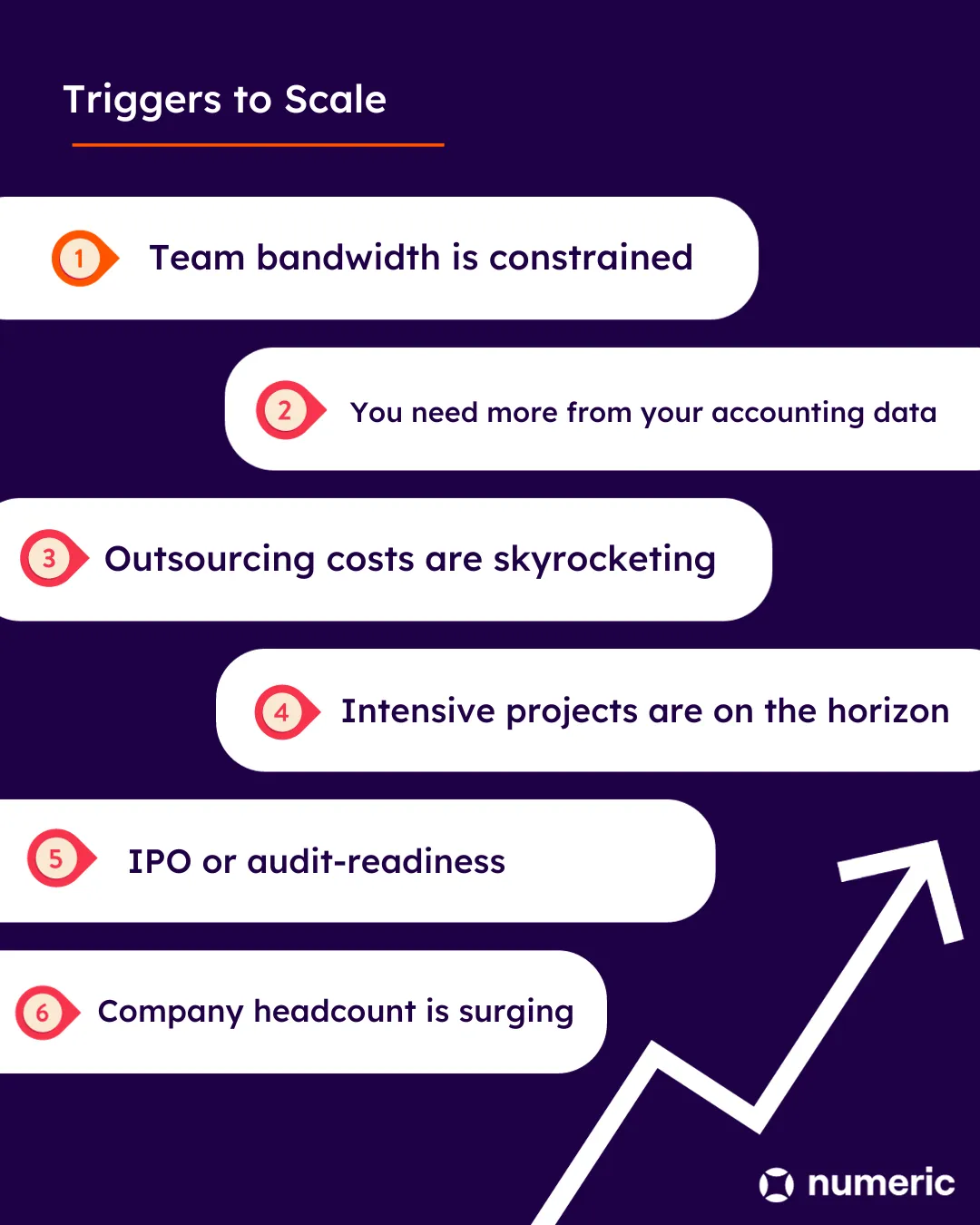
Trigger #1: Team bandwidth is constrained
Oftentimes, there’s a clear signal that new hires are needed from teams struggling to manage the workload volume. Finance and accounting teams primed to grow are on the cusp of:
- Having an impacted ability to secure accurate financials due to current bandwidth constraints
- Struggling with the month-end close
- Being concerned about the current state of financials with an audit on the horizon
- Reporting pressure and FP&A requests that you’re struggling to get to
Like any department, the name of the game is timing new hires just ahead of when work outputs would be impacted, preventing any disruptions but avoiding prematurely spend.
Trigger #2: You need more from your accounting data
What questions are being asked of your accounting data also serves as a key indicator for increased headcount. While back of the napkin math for cash flow may work in the early days of a company, as you hire sales reps, build new products, open additional offices, you now need a nuanced understanding of your performance and future looking finances to make good business decisions.
And the bedrock of forecasting and reporting is the underlying accounting data. When you’re asking more of your accounting data, gradually additional requirements are placed on the data, like tagging operational expenses to departments. The growing list of requirements frequently necessitates additional full time headcount.
“It's really hard, if not impossible, to build a best-in-class finance function without someone focused entirely on producing timely, accurate, detailed accounting data for reporting and forecasting purposes”, Numeric CEO, Parker Gilbert, reflects on his experience identifying triggers to grow his previous accounting team at Hearth.
Trigger #3: Outsourcing costs are skyrocketing
Early on and across the growth trajectory of a company, outsourcing can be an efficient way to handle accounting needs without hiring additional staff members. Yet, as transaction volume, business complexity, and reporting requirements grow, over time outsourcing costs stack up.
One reliable trigger, particularly for early-stage companies, is comparing outsourced costs to the potential cost of a FTE that would otherwise do the work. When outsourcing costs are nearing or exceeding the costs of bringing FTEs on board and there’s a level of certainty in the predictability of work, hiring a new team member may be the logical choice.
Trigger #4: Intensive projects on the horizon
For other teams, big ambitions in upcoming quarters spur the need for increased headcount. Whether the team is transitioning ERPs, launching internationally, or rolling out new business lines, projects slated in the future may indicate demand for new skillsets or for increased hands on deck.
For Travis Sharp, Associate Director of Accounting at Ro, hiring has been triggered by capital raises, acquisitions, and the launch of new business lines. Previously, the addition of a new business line required “additional operational lift that we hadn’t necessarily done before, everything from onboarding new customers, additional reporting to leadership on a more granular level, and operational accounting shifts like understanding complexities in customer contracts and the appropriate revenue recognition.”
Business pivots, product launches, or ERP transitions can all necessitate additional hires.
Trigger #5: IPO or audit readiness
Preparing for a company’s first audit or for an IPO both require an increase in controls, reviews, processes and accounting sophistication writ large. For many companies, approaching this milestone translates to hiring needs.
When companies have the intention of going public, Ioulia Kliachtornaia explains,
“You need to increase the rigor and the accuracy of accounting. Which likely means better systems, more people, and more controls. If the business can avoid non-standard terms and conditions in its contracts with customers and inconsistent business practices, it will greatly reduce accounting complexity and allow for automation. Strict control requirements means requirements on documentation and building separation between who prepares and who reviews certain pieces that go into financial reports.”
Increased controls often go hand-in-hand with a need for a larger team to execute on the new controls.
Trigger #6: Overall company headcount is surging
While every company is unique, a fairly reliable indicator that it’s time to scale the accounting team is company-wide headcount growth, which is typically indicative of an uptick in volume in complexity across all accounting processes (payroll, accounts receivable, etc.).
Exact recommendations will differ slightly depending on your industry. But in general, expect to have:
- 1 person who works part-time as a startup or an outsourced accountant firm at 1-25 people
- 1 high-level, full-time professional or outsourced accounting firm at 25-50 people
- Mix of in-house (typically ~2 full time professionals)/external resources for 50-150 people
- Increasingly bringing work in-house with specialized teams, often a finance headcount of 1-2% of total organization headcount at 150+ people
But again, just because signs show you need to scale doesn’t mean you need to immediately. Focusing on your financial tech stack first can help you handle data more efficiently, automate tasks, and streamline processes in a way that reduces pressure on the existing team.
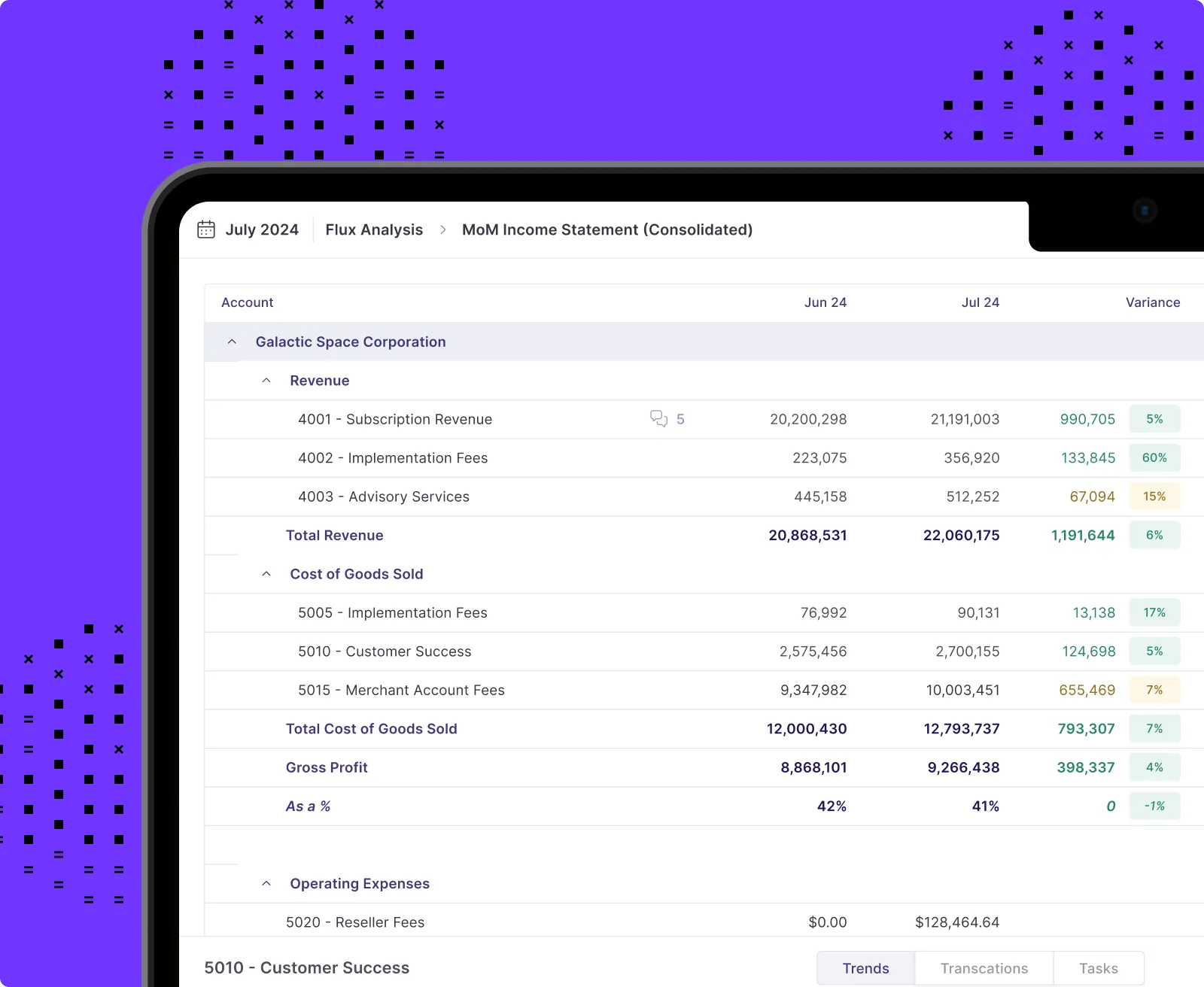
Finally, while headcount and bandwidth are clear indicators that the team needs to grow, the reality of hiring requires, of course, that you have the budget to hire additional team members. For many teams, the question isn’t when to hire but how to get executive support onboard for hiring additional finance and accounting team members.
Again, making planning everything. Accounting leaders need to proactively identify potential bandwidth crunches far ahead of when they become impactful — then present the case to add headcount early on, anticipating the frequent challenge of budget approval.
What size should your accounting team be and what roles do you need?
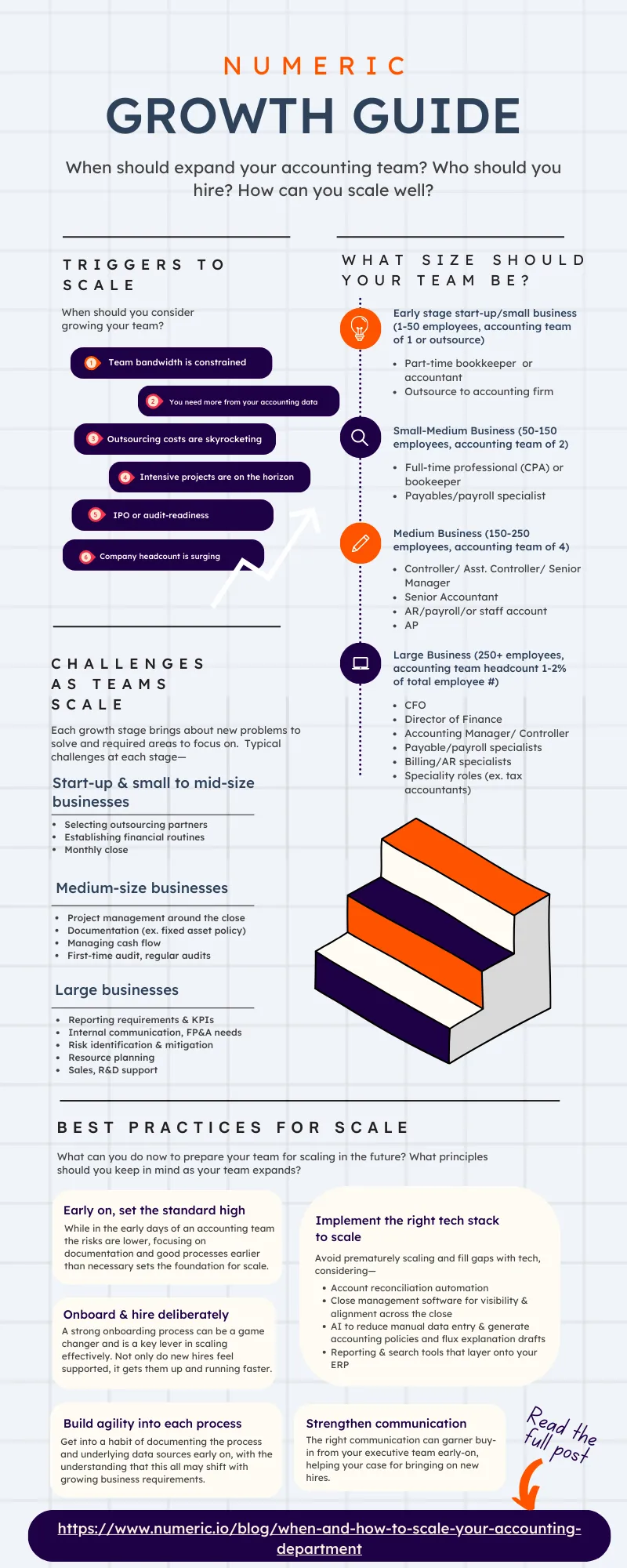
The size of your finance and accounting team varies substantially by business. For example, industries with more compliance and regulation, like Fintech or MedTech, may demand higher headcount from the start. However, in general, you can expect something along these lines—
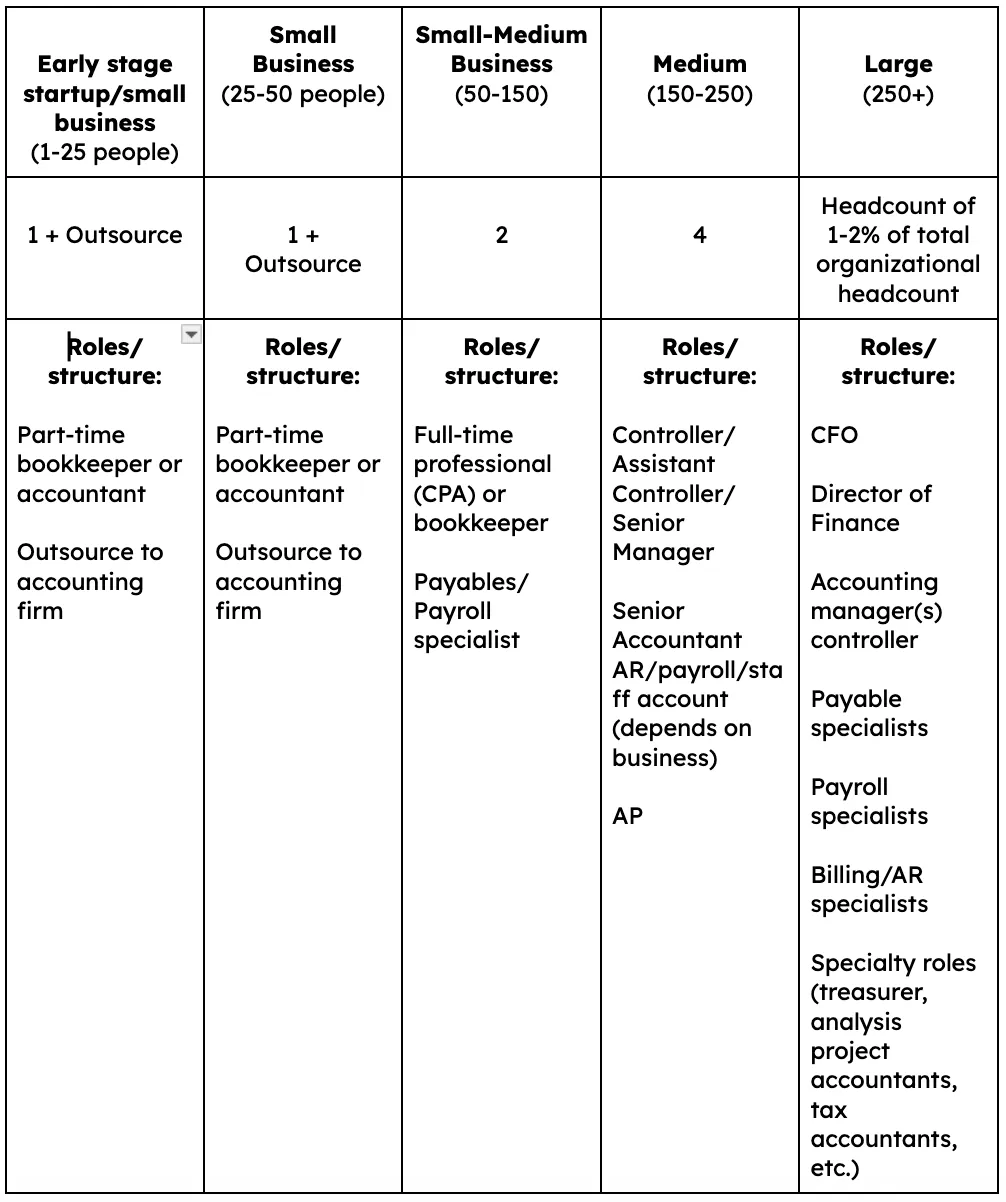
Early stage startup/small business
(1-25 people)
Headcount: 1 + or outsource
Roles/Structure:
- Part-time bookkeeper or accountant
- Outsource to accounting firm
Small Business
(25-50 people)
Headcount: 1-2 or outsource
Roles/Structure:
- Part-time bookkeeper or accountant
- Outsource to accounting firm
Small-Medium Business
(50-150)
Headcount: 2
Roles/Structure:
- Full-time professional (CPA) or bookkeeper
- Payables/
- Payroll specialist
Medium Business
(150-250)
Headcount: 4
Roles/Structure:
- Controller/ Assistant Controller/ Senior Manager
- Senior Accountant
- AR/payroll/staff account (depends on business)
- AP
Large Business
(250+)
Headcount: 1-2% of total organizational headcount
Roles/Structure:
- CFO
- Director of Finance
- Accounting manager(s) controller
- Payable specialists
- Payroll specialists
- Billing/AR specialists
- Specialty roles (treasurer, analysis project accountants, tax accountants, etc.
How should you structure your team?
Your exact team structure and how you expand depends on your business— SaaS is different from retail. Banking and finance will require different skill sets than manufacturers.
However, across all business types, the underlying focus is on identifying where your gaps are and then determining what roles and skills would best fill them.
How to assess accounting gaps
The first step in assessing accounting gaps? Understanding what’s currently being done, where tasks and processes are being pushed, and what dependencies get in your teams’ way.
This is where your existing month-end close checklist, and other documentation, serves an artifact of your team’s bandwidth.
For Jacqueline Meyers, most recently the Senior Director of Accounting at Dandelion Energy, previous gaps have come with implementation of new systems.
“Many companies begin on QuickBooks, but as they develop their internal processes and understand their systems requirements, they frequently transition to a more robust ERP. After the software implementation is complete, the organization in many cases has new and more robust processes to manage given the nature of and reasons for moving on to a new system."
Those new processes then need to be run and maintained by someone, leading to team expansion.
Ask yourself, where are you getting behind? Where is your accuracy suffering? What requests are you not able to get to? Where are workflows bottlenecked?
How to assess what roles you need
Once you understand where you’re struggling, you can look at roles that fit those specific needs. Are you having a hard time organizing the increasingly wieldy month-end close process? Are you ready to bring your payroll in-house? Is your AR or AP getting too big for one person to handle?
If technology can’t help, it may be time to create a role and add it to your team structure. Determine your needs and the tasks the role will cover, and outline the skill set and knowledge level needed to perform the job.
When Numeric CEO Parker Gilbert was determining what role would be the best fit in his previous position leading finance and accounting at Hearth, it boiled down to a function of two needs:
- “We wanted to do more accounting — such as deeper segmentation, but it was prohibitive for an outsourced person to do. But someone in house could knock things out quickly and go to sleep thinking about our business”
- “We had increased complexity on a number of fronts (sales tax, accounting, audits, etc.) and needed someone who could come in to tackle full projects and work autonomously”
After assessing needs, the right hire was a more senior level accountant who didn’t require work to be reviewed deeply and could flexibly approach new projects as they arose.
While considering current gaps, ensure to future proof your needs assessment. Think through where your team will need to focus on more in the future, understanding how the role will fit as you continue to grow.
Where your team focuses is dependent on your growth stage
Each growth stage brings about new problems to solve. Initially, teams must close the books, pay employees, and ensure cash flow. They also start to build a supporting tech stack.
And then as you scale up, demands grow. Teams begin to focus on professionalizing, including budgets and processes. They start monitoring metrics, and reporting and analysis become integral to operations. In general, once you move past the bookkeeping and outsourced accounting phases, the focus becomes:
- Scaling up from startup/ small to midsize business: Bolstering accounting processes to handle higher volumes of transactions, setting up payroll infrastructure, creating strong processes for budgeting, beginning to look at future roles
- Medium-size business: Recurring forecasts, identifying and communicating KPIs, reporting to stakeholders and investors
- Large business: Managing finances across all geographies, managing relationships with stakeholders and investors, and optimizing efficiency and processes
What are typical challenges when growing an accounting team?
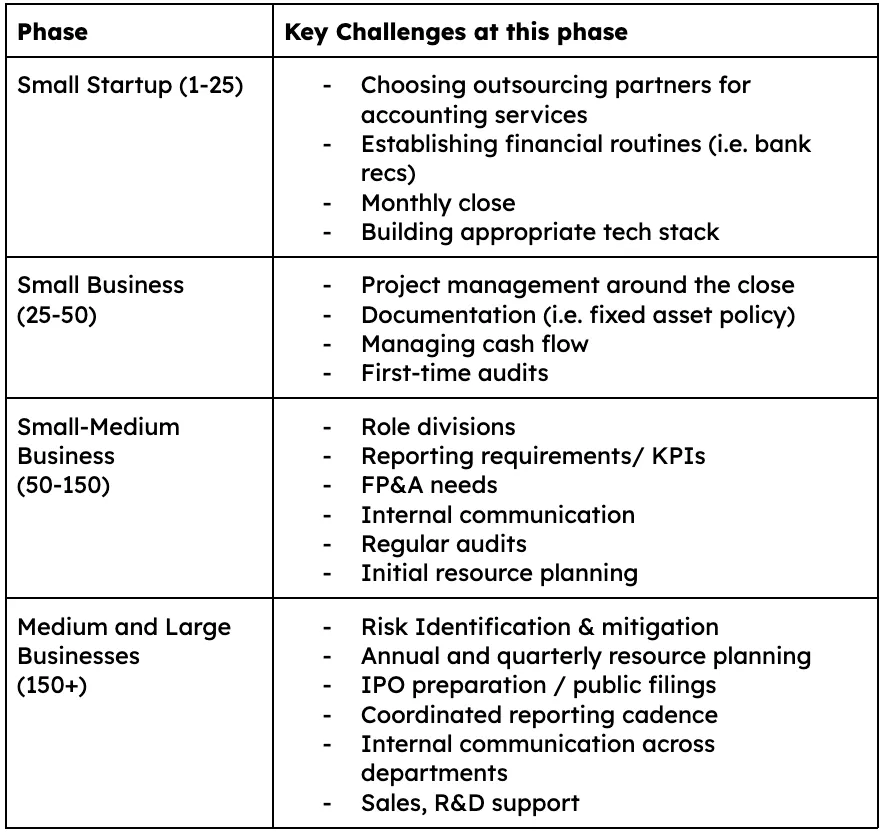
Small Startup (1-25 employees)
- Choosing outsourcing partners for accounting services
- Establishing financial routines (i.e. bank recs)
- Monthly close
- Building appropriate tech stack
Small Business (25-50 employees)
- Project management around the close
- Documentation (i.e. fixed asset policy)
- Managing cash flow
- First-time audits
Small-Medium Business (50-150 employees)
- Role divisions
- Reporting requirements/ KPIs
- FP&A needs
- Internal communication
- Regular audits
- Initial resource planning
Medium and Large Businesses (150+ employees)
- Risk Identification & mitigation
- Annual and quarterly resource planning
- IPO preparation / public filings
- Coordinated reporting cadence
- Internal communication across departments
- Sales, R&D support
Best practices for scaling your accounting team
Scaling well is about always anticipating what’s next, seeing around the corner for inflection points that impact your accounting team.
Part of this involves setting best practices at an earlier stage than required.
1. Early on, set the standard high
Brian Weisberg, CFO of Tidelift, advises,
“I’m a firm believer in establishing good habits early and often rather than down the road when it becomes more painful to change your behavior.”
While in the early days of an accounting team the risks are lower, focusing on documentation and good processes earlier than necessary sets the foundation for scale. Maintaining a clear audit trail, formalizing the month-end close, in the long-run reduces friction and allows teams to function effectively, even as they expand.
2. Implement the right tech stack to scale
The right tech that integrates with your existing systems can reduce the need to increase headcount. You can avoid prematurely scaling and fill gaps with tech by:
- Streamlining core workflows like account reconciliation
- Ensuring alignment and visibility across your team with a well-documented close checklist
- Using AI to reduce manual data entry & generate first drafts of accounting policies and flux explanations
- Implementing tech to help locate answers in your data without digging
And inevitably as company growth occurs, most accounting teams will reach the point they need to switch from more basic software like Quickbooks to an ERP like NetSuite. For a detailed breakdown, check out our comparison of NetSuite vs QuickBooks to help guide the transition.
Beyond ERP selection and even for smaller teams of one or two FTEs, it becomes critical to select tech tools across the board that support and optimize processes.
3. Onboard & hire deliberately
When scaling a team, you may acutely feel the need for a new team member as bandwidth is stretched, but Jacqueline Meyers stresses that even then you should take hiring decisions deliberately and often slowly.
“When you are building out a team, you may be in a position where you want to hire people quickly because there’s an immediate need for it, but you still need to make sure you’re hiring the right person for the right role.”
With scale comes hiring and an influx in onboarding. A strong onboarding process can be a game changer and is a key lever in scaling effectively. Not only do new hires feel supported, it gets them up and running faster.
Accounting teams can provide an excellent onboarding process with:
- Documentation (like Wikis and monthly close process notes) that supports onboarding and provides a seamless transition
- Clear role definitions that defines ownership on Day 1
- A walkthrough of tech stack components that may be unfamiliar early on, ensuring that new team members can get up and running quickly
From her experience, Ioulia Kliachtornaia, Global Financial Controller at Multiverse.io, suggests providing ample context with high transparency to new hires as they begin to build processes for scale. With the right context, new hires can navigate what to build perfectly for the future versus what will inevitably become obsolete in future quarters— “the more information that your accountants have about the business and the vision for the future, the more efficiently they can do their job.”
4. Build agility into each process
Growth demands flexibility and agility. Things change, and it's crucial to adapt processes as you scale to better support the phase you’re in. Get into a habit of documenting the process and underlying data sources early on, with the understanding that this all may shift with growing business requirements.
5. Strengthen communication
Scale inevitably involves a growing number of communication needs with new teams, business entities, and leaders seeking to understand their department finances in greater depth. Accounting teams play a larger role translating their work across departments, enabling a shift to being seen as strategic partners.
The right communication can also garner buy-in from your executive team early-on, helping your case for bringing on new hires. Travis Sharp, Associate Director of Accounting at Ro, advises,
“Ultimately, we are a cost center, but if you can build out a roadmap and illustrate the purpose and importance to the CFO, leaders will hopefully buy-in from the beginning. Then you can migrate to better systems and platforms, including an enterprise ERP, and your team can start building healthy habits and sound processes from the beginning.”
Pay particular attention to building strong communication across teams as well. By documenting clearly who employees across the company should turn to when they have specific questions, your team will save time in the long-run, preventing back-and-forth. Learn how to translate your information, core KPIs, and reporting effectively and in a way that everyone understands regardless of department background.
And keep communication strong with FP&A as both teams develop. Accounting team growth often comes in tandem with the increased scope of the FP&A function, making a strong relationship between both teams critical as complexity grows on both sides. The tone is often set from the top and early on, necessitating that teams invest in communication with FP&A across the journey of scaling.
In conclusion
The hope for many businesses is growth. And the accounting team is integral to making that happen, making it essential to scale effectively with the rest of the company. While every growth journey is different, by staying one step ahead with an eye towards scaling, accounting leaders future-proof their team and are proactive for what’s next.



















.png)
.png)
.png)